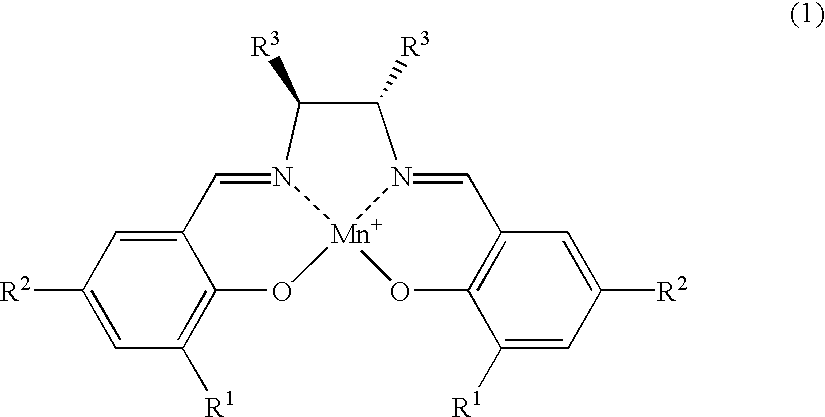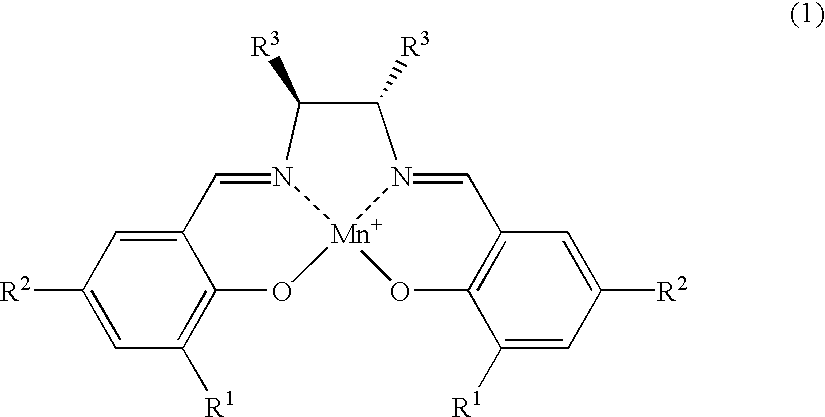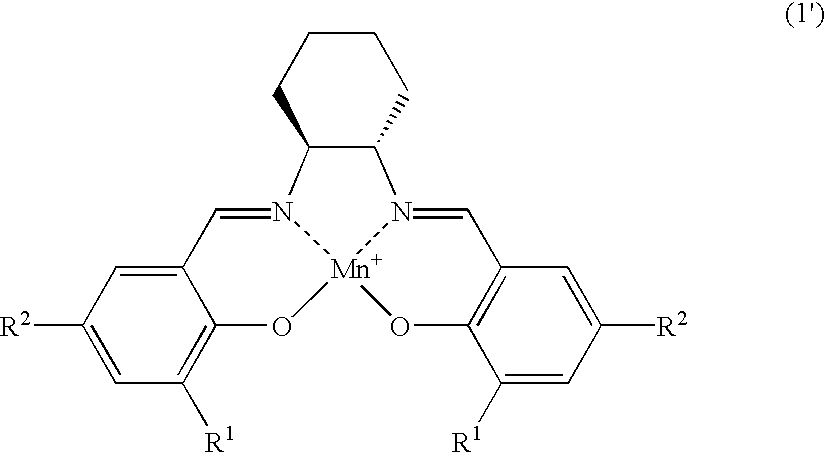Process for preparing amino compounds by using salen-manganese complexes as the catalyst
- Summary
- Abstract
- Description
- Claims
- Application Information
AI Technical Summary
Problems solved by technology
Method used
Image
Examples
example 1
Amination of Indan
[0025] The amination was carried out for the C--H bond at the benzyl position of indan as the starting material, in accordance with reaction formula (8): 7
[0026] The salen-manganese complexes used as the catalyst are shown in FIG. 1. The amount of catalyst used was 6 mol %. The amination agent was (p-toluenesulfonyl) iminophenyliodinane and the reaction was carried out in CH.sub.2Cl.sub.2 solvent at a reaction temperature of 5.degree. C. in the presence of a molecular sieve (MS-4A) as the dehydrating agent. The results are shown Table 1.
1TABLE 1 Complex Reaction Optical Run No. (catalyst) Time(h) Yield (%).sup.a) ee (%).sup.b) Isomer.sup.c) 1 1 3 37 5 S 2 2 3 59 41 S 3 3 3 63 44 S 4 ent-3 3 70 43 R 5 4 3 44 26 S 6 5 3 54 5 S 7 6 3 58 3 S 8 ent-7 3 18 6 R 9 8 3 32 16 S 10 9 3 25 4 S 11 10 3 12 23 S .sup.a)Calculated from the quantity of TsN.dbd.IPh used. .sup.b)By HPLC analysis (DAICEL CHIRALPAK AD, hexane:2-propanol = 9:1) .sup.c)Determined from the order of elutio...
example 2
Study on Solvent and Reaction Temperature
[0030] The amination reaction of indan was carried out in a similar manner as in Example 1, with varying types of solvent and reaction temperature, by using salen-manganese complex No. 3 as shown in FIG. 1 as the catalyst. The results are shown in Table 2.
2TABLE 2 Reaction Reaction Run Temperature Time Yield ee Optical No. Solvent (.degree. C.) (h) (%).sup.a) (%).sup.b) Isomer.sup.c) 1 CH.sub.2Cl.sub.2 5 3 63 44 S 2 CH.sub.3CN 5 3 0 -- --3 CH.sub.3CO.sub.2C.sub.2H.sub.5 5 3 19 32 S 4 CH.sub.3COCH.sub.3 5 3 17 36 S 5 C.sub.6H.sub.5CH.sub.3 5 3 9 42 S 6 C.sub.6H.sub.5Cl 5 3 62 47 S 7 CHCl.sub.3 5 3 62 47 S 8 (CH.sub.2Cl).sub.2 5 3 57 44 S 9 (CHCl.sub.2).sub.2 5 3 74 54 S 10 (CHCl.sub.2).sub.2 -20 12 72 61 S 11 (CHCl.sub.2).sub.2 -40 24 63 66 S .sup.a), b), and c)The same as in Table 1
[0031] As can be seen from in Table 2, the reaction was slow where acetonitrile, ethyl acetate, acetone or toluene was used as the solvent (Run Nos. 2 through 5). ...
example 3
Aminations of Various Compounds
[0032] The amination reaction was carried out with cyclohexene, tetralin, 1,1-dimethyltetralin or 1,1-dimethylindane as the starting alkene or alkylarene. The catalyst was salen-manganese complex No. 3 as shown in FIG. 1. The reaction was conducted for 24 hours at -40.degree. C. using 1,1,2,2-tetrachlorethane as the solvent. The results are shown in Table 3.
3TABLE 3 Run No. Substrate Product Yield(%).sup.a) ee(%) 1 8 9 44 67.sup.b) 2 10 11 42 41.sup.b) 3 12 13 67 77.sup.d) 4 14 15 44 82.sup.e) 5 16 17 71 89.sup.f) .sup.a)Calculated from the quantity of TsN.dbd.IPh used. .sup.b)By HPCL analysis (DAICEL CHIRALPAK AD, hexane:ethanol = 9:1). .sup.c)Analysis by .sup.1H NMR showed that a small amount of aziridine was produced. .sup.d)By HPLC analysis (DAICEL CHIRALPAK AD, hexane:2-propanol = 9:1). .sup.e)By HPLC analysis (DAICEL CHIRALPAK AD, hexane:ethanol = 19:1). .sup.f)By HPLC analysis (DAICEL CHIRALPAK AD, hexane:2-propanol = 40:1).
[0033] In the case of...
PUM
| Property | Measurement | Unit |
|---|---|---|
| Length | aaaaa | aaaaa |
| Fraction | aaaaa | aaaaa |
| Fraction | aaaaa | aaaaa |
Abstract
Description
Claims
Application Information
 Login to View More
Login to View More - Generate Ideas
- Intellectual Property
- Life Sciences
- Materials
- Tech Scout
- Unparalleled Data Quality
- Higher Quality Content
- 60% Fewer Hallucinations
Browse by: Latest US Patents, China's latest patents, Technical Efficacy Thesaurus, Application Domain, Technology Topic, Popular Technical Reports.
© 2025 PatSnap. All rights reserved.Legal|Privacy policy|Modern Slavery Act Transparency Statement|Sitemap|About US| Contact US: help@patsnap.com



